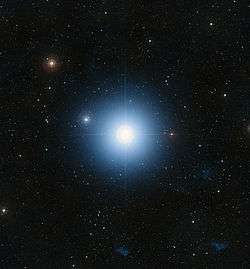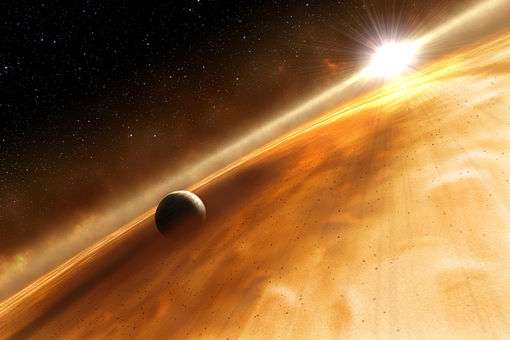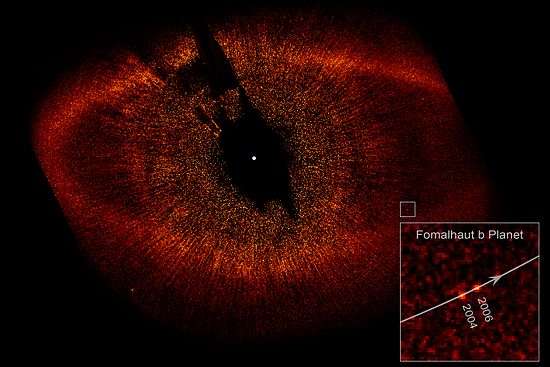Fomalhaut C
Fomalhaut C or its original name, LP 876-10 is the distant third star of the Fomalhaut system. It is currently 2.5 light years (0.77 pc) from Fomalhaut A, and 3.2 light years away from Fomalhaut B (0.987 pc). The entire system is only around 25 light years (7.7 parsecs) from our Solar System. It was originally catalogued as a lone red dwarf, until October 2013, when Eric Mamajek announced that the star had a distance, velocity and color-magnitude position consistent with it being part of the Fomalhaut system. It was most likely catalogued with no relation to Fomalhaut due to the fact that it is in the Aquarius constellation, while the rest of the system are in the Piscis Austrinus constellation.[1]
Discovery and observation

Fomalhaut C was catalogued as a high-proper-motion star by Willum Luyten in 1979, and later, in October 2013, was discovered to be part of the Fomalhaut system, giving it the name Fomalhaut C. The star has a mass of 0.2 solar masses, (0.2 M☉) while Fomalhaut A is 1.9 M☉, and Fomalhaut B is 0.7M☉. The magnitude of this star has been recorded as 12.6. With this third star being so distant, the entire Fomalhaut system may be the widest-spanning star system that has ever been discovered. In the sky, Fomalhaut C would appear very far away from Fomalhaut, which is part of the fact of how close this system is. The distance in the night sky would be 5.5°, or around 11 full moons.[2] Due to its magnitude, you would require a telescope to observe it at home. The entire system of Fomalhaut is around 440 million years old, which is roughly a tenth of the Solar System's age.[3]

Debris disc
In December 2013, a debris disc was discovered around this star.[4][5] This is the second debris disc in the system, as a first one was discovered around Fomalhaut A. The debris disc was dicsovered with the Herschel Space Telescope, and with the telescope the debris disc's temperature has been estimated at 24 kelvins. The distance from the star was originally thought to be around 10 AU, but since it is hypothesized that it is mainly small grains, which trap more heat, it may be further. However, if it were beyond 40 AU, it would have been already cataloged, which gives it a radius between 10 and 40 AU.
Comets
In part with the debris disc, there are also comets orbiting Fomalhaut C.[6] The debris disc orbiting C is sometimes referred to as a comet belt, due to some very elliptical orbits. The disc around Fomalhaut A is also thought to have many comets, as it is also elliptical, along with Fomalhaut b (the planet, not to be confused with Fomalhaut B, the star). The Fomalhaut A belt is thought to possibly be due to a close encounter with either an undiscovered exoplanet, Fomalhaut B, or Fomalhaut C. With both A and C having comet belts, the absence of one around B is a mystery. Not only does the presence of comets make the belt more elliptical, it also makes it brighter which takes a part in its discovery.[7][8]
With Fomalhaut b being hidden in the comets, this leads to a hypothesis that C could have hidden exoplanets within its comets and asteroids.[9] There is another theory that A & C have interacted which could have formed C's comet belt if the interaction involved A giving up comets and debris.[10] With Fomalhaut B not having any discs or belts around it, it could have been unaffected by the encounter between them.
Orbit
The orbit of Fomalhaut C around A is estimated to take 20 million years to complete.[11] Due to the age of the three stars being 440 million years, and the distance of 2.5 light years, this would mean that Fomalhaut C has only completed a full orbit around Fomalhaut A 22 times.[12] The tidal radius of the Fomalhaut system is 6.2 light years (1.9 parsecs), which makes Fomalhaut C well within it, which further proves the Fomalhaut system as trinary.
See also
References

- ↑ King, Bob (2014-10-01). "Fomalhaut: A Crazy-Wide Triple Star - Sky & Telescope". Skyandtelescope.com. Retrieved 2016-01-17.
- ↑ "Researchers find that bright nearby double star Fomalhaut is actually a triple". Astronomy.com. 2013-10-08. Retrieved 2016-01-17.
- ↑ "Fomalhaut: Actually Triple Star, Astronomers Say | Astronomy". Sci-News.com. 2013-10-04. Retrieved 2016-01-17.
- ↑ "Fomalhaut's Little Sibling Has a Debris Disk Too". Astrobites.org. 2013-12-31. Retrieved 2016-01-17.
- ↑ Hall, Shannon (2014-01-21). "Surprise! Fomalhaut's Kid Sister Has a Debris Disk Too". Universe Today. Retrieved 2016-01-17.
- ↑ "Companion's comets the key to curious exoplanet system?". Ras.org.uk. Retrieved 2016-01-17.
- ↑ "Herschel Discovers a Comet Belt around Fomalhaut C". SciTech Daily. Retrieved 2016-01-15.
- ↑ "Second Asteroid Ring Found In Three-Star Planetary System". Headlines & Global News. 2013-12-28. Retrieved 2016-01-15.
- ↑ "Fomalhaut's Stellar Sister's Comets: Exoplanet Goldmine? : Discovery News". News.discovery.com. 2013-12-18. Retrieved 2016-01-17.
- ↑ Paul Gilster. "Cometary Clues to the Fomalhaut System?". Centauri-dreams.org. Retrieved 2016-01-17.
- ↑ "ScienceShot: A 20-Million-Year Orbit". Science | AAAS. Aaas.org. Retrieved 2016-01-15.
- ↑ "The existence of a third star in the Fomalhaut system - Spacefan.org". Spacefan.org. Retrieved 2016-01-15.